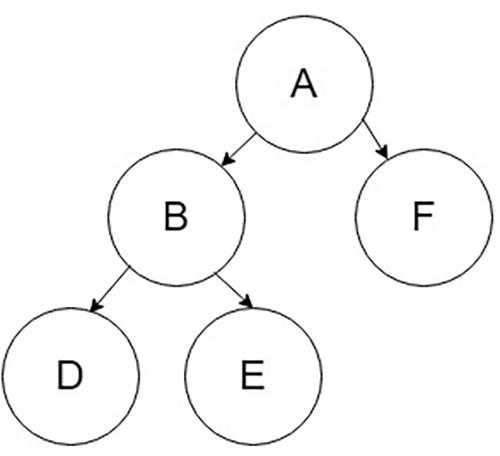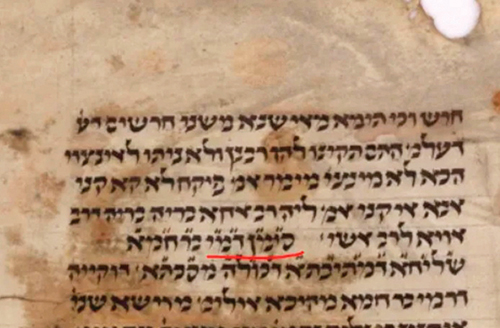
On Bava Metzia 116, Rami bar Chama poses two questions. The Mishna had stated a kelal, a general rule, that (i) when someone has higher precedence in inheritance over some group his descendants have higher precedence over that group as well. Also, (ii) the father precedes all his own descendants.
Thus, referring toFigure 1, (i) if A dies and leaves a son B and a daughter F, then B has priority, and so do his children D and E. In computer science / graph theory terms, we are dealing with a depth-first traversal, visiting A, visiting B, then visiting all of B’s descendants, before moving on to A’s next priority child, F. This is as opposed to a breadth-first traversal, in which B and F should be considered before any of their descendants. Additionally, (ii) within depth-first traversals, there’s preorder, in which B precedes D and E, and postorder, in which D and E precede B. The rule here is preorder.
Rami bar Chama poses the following. D (Esav) is the deceased, with no children, and B (Yitzchak) is already deceased. (Erase E, Yaakov, from the diagram). The choice is between B’s father, A (Avraham) and B’s father’s other son, F (Yishmael). Who has precedence, A or F? Rava answers by citing rule (ii), that the father precedes any descendants.
This seems so straightforward that the Talmudic Narrator wonders why Rami bar Chama even considered this an inquiry. The answer: אַגַּב חוּרְפֵּיהּ לָא עַיֵּין בָּהּ, because of his sharpness, he didn’t pay attention or analyze the Mishna properly.

Rami then poses another inquiry. What about where Esav (D) dies, and Yitzchak (B) has already died? The competing claims are between E (Yaakov) and A (Avraham). Who wins? Again, Rava resolves this from rule (ii). This time, the Narrator provides a reason for Rami thinking otherwise.
In a Mishna in Eruvin, the Sages maintain that if two roofs are adjoined, each is its own domain. Rav said this meant that one could only carry an object on an individual roof within four cubits; Shmuel permits carrying throughout the roof. On Eruvin 90a, Rami bar Chama poses the question: According to Rav, can one carry two cubits on a roof and then another two cubits on a ten handbreadth high and four by four handbreadth wide pillar? Rava wonders what Rami was asking, and the Talmudic Narrator explains אַגַּב חוּרְפֵּיהּ לָא עַיֵּין בַּהּ that because of his keen mind, Rami wasn’t careful. There, this means he was imprecise in his formulation, and the Narrator reimagines the inquiry. We have two such imprecise cases.
Defending Rami bar Chama
We might defend Rami somewhat. First, our printed piska – the quoted portion of the Mishna preceding each sugya, appearing between colons – is rather long, and includes principle (ii): זֶה הַכְּלָל: כׇּל הַקּוֹדֵם בַּנַּחֲלָה – יוֹצְאֵי יְרֵכוֹ קוֹדְמִין, וְהָאָב קוֹדֵם לְכׇל יוֹצְאֵי יְרֵכוֹ. Many manuscripts, however, have the much shorter זה הכלל כל הקודם בנחלה וגו׳.
Further, Rami bar Chama wasn’t reacting to the Mishna. The Talmudic redactors took his statement and attached it to this Mishna because Rava’s answer is from this Mishna. Indeed, the piska is much later –from the Geonic period. While Amoraim can be expected to know all Mishnayot but not all braytot, that doesn’t mean that our Mishna was at the top of Rami bar Chama’s mind.
Finally, I don’t see how Rava’s resolution was so obvious. This may be because I lack expertise in reading Mishnayot like an Amora, or perhaps my keen mind is misleading me. A kelal in a Mishna isn’t a general rule that applies universally, but a generalization of the cases in the Mishna. Saying that the father precedes the son in inheritance isn’t always true – for instance, if D dies, B precedes A. It’s only B’s brother F who doesn’t precede A, because the inheritance must pass through A on the way to F. Indeed, rule (ii) seems like a qualification of rule (i), namely that the depth-first traversal is preorder. It might not apply when inheritance travels up the tree.
Rami (Rav Ami) bar Chama was a fourth-generation Babylonian Amora. He and his brother, Mar Ukva bar Chama, married Rav Chisda’s daughters. After Rami’s death and 10 years of widowhood, his widow married another famous fourth-generation Amora, Rava. This fulfilled her prophetic words uttered as a child. Rami and Rava were Rav Chisda’s students, and Rav Chisda’s daughter sat on his lap as they learned. Rav Chisda jokingly asked her which of his students she wanted to marry, and she replied, “Both of them!” Rava said, “And I will be last.”
Throughout the Talmud, Rami bar Chama poses these inquiries and Rava resolves them. It isn’t the teacher, Rav Chisda, who resolves the inquiries, as you might find when Rava inquires of his primary teacher, Rav Nachman. This makes me believe that Rami bar Chama isn’t a know-nothing, who is subservient in knowledge to Rava. Rather, his role in Rav Chisda’s academy was to set the research agenda. He would review sources and set up questions, often with an idea as to the resolution. Still, all the teachers and students would discuss and present arguments. Thus, Rami often set up the bowling pins and Rava would knock them down.
Illustrating his relationship to research questions, in Bava Kamma 20a, Rav Chisda said to Rami bar Chama, “You weren’t with us last night in our boundary / study hall when we raised dilemmas about excellent matters.” Rami inquired what matters and Rav Chisda explained. Rami said he could resolve it from a Mishna, but only after his teacher Rav Chisda performed an act of service for him. Rav Chisda folded Rami’s scarf and Rami explained. Rav Chisda accepted the resolution, but Rava disagreed that it was valid proof.
Vatican 115a manuscript, Bava Metzia 8a.
In the Escorial and Vatican 115a manuscripts of Bava Metzia 8a, a siman (mnemonic) states that Rami bar Chama is the agent of the academy throughout the tractate. “The tractate” might mean Bava Metzia, or the larger Nezikin tractate. This was brought up when an Amora asks Rav Ashi about Rami bar Chama’s inference from the Mishna that הַמַּגְבִּיהַּ מְצִיאָה לַחֲבֵירוֹ – קָנָה חֲבֵירוֹ. Such simanim are late, and might be helpful for scribes or reciters, but still might speak to Rami bar Chama’s central role.
Therefore, maybe we needn’t believe that Rami bar Chama erred due to his intellect, or figure out how Rami bar Chama (mis)interpreted a source such that he had to pose a question or didn’t see Rava’s resolution. He set the research agenda by formulating these questions. He might have suspected that both his inquiries could be resolved by rule (ii), but posed both in order to spark the discussion.
Rabbi Dr. Joshua Waxman teaches computer science at Stern College for Women, and his research includes programmatically finding scholars and scholastic relationships in the Babylonian Talmud.








